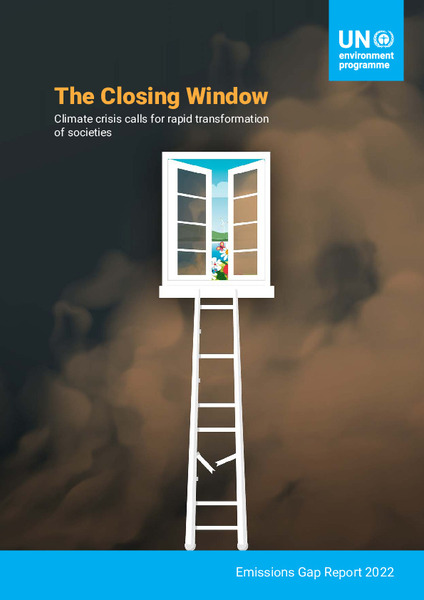| dc.contributor | Science Division | en_US |
| dc.contributor.author | United Nations Environment Programme | en_US |
| dc.contributor.other | Olhoff, Anne | en_US |
| dc.contributor.other | Christensen, John | en_US |
| dc.contributor.other | Lamb, William F. | en_US |
| dc.contributor.other | Grassi, Giacomo | en_US |
| dc.contributor.other | Kuramochi, Takeshi | en_US |
| dc.contributor.other | den Elzen, Michel | en_US |
| dc.contributor.other | Fransen, Taryn | en_US |
| dc.contributor.other | Rogelj, Joeri | en_US |
| dc.contributor.other | Portugal-Pereira, Joana | en_US |
| dc.contributor.other | Höhne, Niklas | en_US |
| dc.contributor.other | Levin, Kelly | en_US |
| dc.contributor.other | Roy, Joyashree | en_US |
| dc.contributor.other | Mosnier, Aline | en_US |
| dc.contributor.other | Springmann, Marco | en_US |
| dc.contributor.other | Fan, Shenggen | en_US |
| dc.contributor.other | Pauw, Pieter | en_US |
| dc.contributor.other | Dasgupta, Dipak | en_US |
| dc.contributor.other | de Coninck, Heleen | en_US |
| dc.date.accessioned | 2022-10-19T13:29:26Z | |
| dc.date.available | 2022-10-19T13:29:26Z | |
| dc.date.issued | 2022-10 | |
| dc.identifier.uri | https://wedocs.unep.org/20.500.11822/40874 | |
| dc.description | This thirteenth edition of the Emissions Gap Report is a testimony to inaction on the global climate crisis. In just eight years, global GHG emissions must be reduced by 30 to 45 per cent compared to where they are headed under policies currently in place to get on track to limiting global warming to well below 2.0°C and 1.5°C respectively. Commitments by countries as expressed in their latest unconditional and conditional nationally determined contributions (NDCs) for 2030 will only reduce global emissions by 5 to 10 per cent, assuming that they are fully implemented. The report looks at transformations required in electricity supply, industry, transport, buildings, food systems and the financial system.
The report i) assesses the trends in global GHG emissions, including the effects of COVID-19, and considers consumption-based emissions and their distribution between and within countries; ii) provides an updated global landscape of NDCs and long-term net-zero emissions pledges, and assesses the progress of G20 members towards achieving their NDCs and net-zero emissions pledges; iii) updates the assessment of the emissions gap by 2030 based on the latest NDCs, and considers the implications of the emissions gap on the feasibility of achieving the long-term temperature goal of the Paris Agreement; iv) provides the status of the transformation towards zero GHG emissions in the sectors of electricity supply, industry, transportation and buildings, and identifies actor-based actions that could accelerate the transformation; v) provides an assessment of the food systems transformations needed, whether there are signs that they are happening, and how they could be accelerated; and vi) considers the transformations of the finance system needed to enable the achievement of the Paris Agreement. | en_US |
| dc.format | Text | en_US |
| dc.language | English | en_US |
| dc.relation.ispartof | Emissions Gap Report | en_US |
| dc.rights | Public | en_US |
| dc.subject | climate change | en_US |
| dc.subject | climate change mitigation | en_US |
| dc.subject | greenhouse gas emission | en_US |
| dc.subject | electricity | en_US |
| dc.subject | industry | en_US |
| dc.subject | transportation | en_US |
| dc.subject | building | en_US |
| dc.subject | food chain | en_US |
| dc.subject | environmental financing | en_US |
| dc.title | Emissions Gap Report 2022: The Closing Window - Climate Crisis Calls for Rapid Transformation of Societies | en_US |
| dc.type | Publications | en_US |
| dc.type | Institutional Series | en_US |
| dcterms.hasPart | <a href="https://wedocs.unep.org/20.500.11822/40932">Executive Summary</a> | |
| dcterms.hasPart | <a href="https://wedocs.unep.org/20.500.11822/40925">Chapter 1. Introduction</a> | |
| dcterms.hasPart | <a href="https://wedocs.unep.org/20.500.11822/40926">Chapter 2. Global emissions trends</a> | |
| dcterms.hasPart | <a href=" https://wedocs.unep.org/20.500.11822/40927">Chapter 3. Nationally determined contributions and long-term pledges: The global landscape and G20 member progress</a> | |
| dcterms.hasPart | <a href="https://wedocs.unep.org/20.500.11822/40928">Chapter 4. The emissions gap</a> | |
| dcterms.hasPart | <a href="https://wedocs.unep.org/20.500.11822/40929">Chapter 5. Transformations needed to achieve the Paris Agreement in electricity supply, industry, buildings and transportation</a> | |
| dcterms.hasPart | <a href="https://wedocs.unep.org/20.500.11822/40930">Chapter 6. Transforming food systems</a> | |
| dcterms.hasPart | <a href="https://wedocs.unep.org/handle/20.500.11822/40931">Chapter 7. Transforming the finance system to enable the achievement of the Paris Agreement</a> | |
| dcterms.hasPart | <a href="https://wedocs.unep.org/20.500.11822/41221">Appendices</a> | |
| wd.identifier.sdg | SDG 2 - Zero Hunger | en_US |
| wd.identifier.sdg | SDG 9 - Industry, Innovation and Infrastructure | en_US |
| wd.identifier.sdg | SDG 12 - Responsible Consumption and Production | en_US |
| wd.identifier.sdg | SDG 13 - Climate Action | en_US |
| wd.identifier.pagesnumber | 153 p. | en_US |


